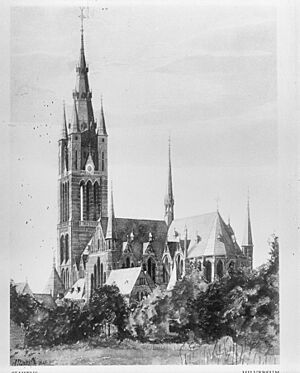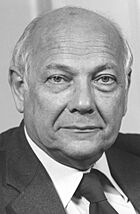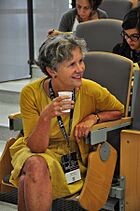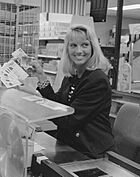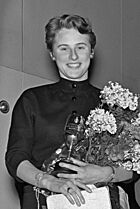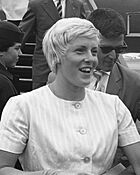Hilversum facts for kids
Quick facts for kids
Hilversum
|
|||
|---|---|---|---|
|
City and municipality
|
|||

Hilversum Town Hall
|
|||
|
|||
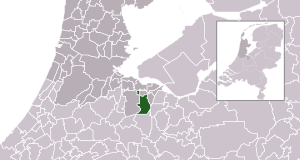
Location in North Holland
|
|||
| Country | Netherlands | ||
| Province | North Holland | ||
| Region | Amsterdam metropolitan area | ||
| Town Hall | Hilversum Town Hall | ||
| Government | |||
| • Body | Municipal council | ||
| Area | |||
| • Total | 46.35 km2 (17.90 sq mi) | ||
| • Land | 45.62 km2 (17.61 sq mi) | ||
| • Water | 0.73 km2 (0.28 sq mi) | ||
| Elevation | 15 m (49 ft) | ||
| Population
(May 2014)
|
|||
| • Total | 90,261 | ||
| • Density | 1,903/km2 (4,930/sq mi) | ||
| Demonym(s) | Hilversummer (male), Hilversumse (female) | ||
| Time zone | UTC+1 (CET) | ||
| • Summer (DST) | UTC+2 (CEST) | ||
| Postcode |
1200–1223
|
||
| Area code | 035 | ||
Hilversum is a city and municipality in the Netherlands. It is located in the province of North Holland. Hilversum is the biggest city in the Gooi region. It is surrounded by beautiful nature, like heathland, woods, meadows, and lakes.
This city is famous for being the "media city" of the Netherlands. Many big radio, television, and newspaper companies are based here. Hilversum is part of the Randstad, a very large group of cities in Europe. It is about 22 kilometers southeast of Amsterdam and 15 kilometers north of Utrecht.
Contents
About Hilversum
Hilversum is about 24 kilometers southeast of Amsterdam. It is also 15 kilometers north of Utrecht. The city is well-known for its amazing Town Hall. This building was designed by Willem Marinus Dudok and finished in 1931.
Hilversum has a public library and two swimming pools. There are also several sports halls. You can find many shopping centers here, like Hilvertshof. Even though it's a city, locals sometimes call the town center "het dorp," which means "the village."
Hilversum's Geography
Hilversum is built on sandy, hilly land in the Gooi region. It has four main hills. These include the Boomberg and the Trompenberg. The hills were formed during the Ice-age. At that time, glaciers covered the area.
Hilversum is surrounded by many other towns. Some of these are Bussum, Laren, and Blaricum.
The city is divided into different areas and neighborhoods. These include the Center, Northwest, and Southeast. In the past, in 1767, Hilversum had only four main areas.
The Oude Haven (Old Harbor) is in the southwest. It is at the end of the Gooische Vaart canal. This canal was built over 240 years and finished in 1876. Today, there is also a modern harbor and a leisure harbor for boats.
International Connections
Hilversum has several international schools. These include the Violenschool and the International School Hilversum "Alberdingk Thijm".
Big international companies also have offices here. For example, Nike, Hunkemöller, and Converse have their European headquarters in Hilversum.
Hilversum's History
Ancient Times
Very old pottery found in Hilversum gives its name to the Hilversum culture. This was a group of people living here in the Bronze Age, from about 1800 to 1200 BC. Their artifacts are similar to those found in southern Britain. This might mean the first Hilversum residents came from that area.
Early Settlements and Growth
The first brick homes appeared around 900 AD. Hilversum was first officially mentioned in 1305. Its name, "Hilfersheem," means "houses between the hills." At that time, it was part of Naarden, the oldest town in the Gooi area.

In the Middle Ages, people in the Gooi region made money from farming, raising sheep, and making wool. In 1424, Hilversum became officially independent. This helped the town grow because it no longer needed permission from Naarden for new businesses.
The town grew even more in the 17th century. The Dutch economy was strong, and canals were built. These canals connected Hilversum indirectly to Amsterdam.
Challenges and Recovery
In 1725 and 1766, big fires destroyed most of the town. Parts of the old town hall and church were burned down. But the town recovered from these problems. The textile industry continued to grow. They even found a way to weave cows' hair!
In the 19th century, the textile and tapestry industry became very important. A railway line to Amsterdam was built in 1874, which helped a lot. From then on, Hilversum grew quickly. Rich people from Amsterdam started moving here. They built large villas in the wooded areas. Even with all this growth, Hilversum never officially became a "city." That's why many locals still call it "het dorp," or "the village."
Modern Times
Hilversum hosted parts of the 1928 Summer Olympics. It held the non-jumping equestrian events and the running part of the modern pentathlon.
In the early 1920s, the Nederlandse Seintoestellen Fabriek (NSF) company opened a radio factory in Hilversum. It became the biggest of its kind in the Netherlands.
During World War II, after the Netherlands was taken over by Nazi Germany, Hilversum became the headquarters for the German Army. In February 1941, many factories in Hilversum went on strike. This was a protest against the start of the Holocaust. About 10,000 people took part. Sadly, about 2,000 Jewish people from Hilversum lost their lives during the Holocaust.
In 1948, Philips took over NSF. However, Dutch radio and later television companies started to centralize their operations in Hilversum. This helped the city's economy keep growing. Because of this, Hilversum became known as the media city of the Netherlands.
In 1964, Hilversum's population reached its highest point, with over 103,000 people. But the textile industry started to decline. Other factories also closed. After the 1960s, the population slowly went down. It has now stabilized and is growing again.
The town has made many improvements. They renovated the central train station and the main shopping center. New dining and shopping areas have also been developed. Important new buildings include the Netherlands Institute for Sound and Vision. Also, Zanderij Crailoo is the largest man-made wildlife crossing in the world.
The nearby Media Park has been the site of some important events. In 2002, politician Pim Fortuyn was assassinated there. In 2015, a person with a fake gun entered the Nederlandse Omroep Stichting headquarters. They demanded to be on the news.
Culture in Hilversum
Hilversum has a large Catholic church called St. Vitus. It is a beautiful neo-gothic building with a 96-meter tall bell tower. Many landscape artists visited Hilversum in the 19th century.
In the 1950s and 1960s, the city hosted a major European Tennis tournament.
Hilversum also hosted the 1958 Eurovision Song Contest. In 2020, the international TV event Eurovision: Europe Shine a Light was broadcast from Hilversum. This event took the place of the 2020 contest, which was canceled due to the COVID-19 pandemic.
Broadcasting Hub
Hilversum is often called the "media city." It is the main center for radio and television in the Netherlands. It has many radio and television studios. It is also where the main offices of the Netherlands Public Broadcasting system are located. Many newer commercial TV companies are also here.
Because of Hilversum's history as a radio center, many old radios in Europe had "Hilversum" marked on their tuning dials. This showed how important it was for broadcasting.
Dutch national voting for the Eurovision Song Contest is usually managed from Hilversum.
Getting Around Hilversum
Airport
Hilversum has its own airport, Hilversum Airfield. It is in the southwest of the city. During wartime, the German military made the airfield much bigger. They also set up a factory there to build training aircraft.
Train Travel
Hilversum has good connections to the Dutch railway system. It has three train stations:
- Hilversum
- Opened in 1874.
- Serves regional, Intercity, and international trains.
- Hilversum Media Park
- Opened in 1974.
- Only serves regional trains.
- Hilversum Sportpark
- Opened in 1886.
- Only serves regional trains.
Public Buses
Most local and regional buses are run by Connexxion. Other companies like Syntus Utrecht and U-OV also operate some routes. In 2018, work started on a new fast bus lane from Hilversum to Huizen.
Famous People from Hilversum
Many well-known people were born in Hilversum. Here are a few:
Public Service & Thinkers
- Joop den Uyl (1919–1987)
- Was the Prime Minister of the Netherlands from 1973 to 1977.
- Hubert van Es (1941–2009)
- A war journalist famous for his work in Vietnam.
- Olga Fischer (born 1951)
- A Dutch linguist and university professor.
- André Rouvoet (born 1962)
- A retired Dutch politician.
Arts and Entertainment
- Emmy Lopes Dias (1919–2005)
- A Dutch actress for stage, radio, and TV.
- Pim Jacobs (1934–1996)
- A Dutch jazz pianist, composer, and TV presenter.
- Arjan Ederveen (born 1956)
- A Dutch actor, comedian, and TV director.
- Arjen Anthony Lucassen (born 1960)
- A Dutch singer, songwriter, and musician.
- Nicolette Kluijver (born 1984)
- A Dutch TV presenter and former model.
- Lucas & Arthur Jussen (Lucas born 1993, Arthur born 1996)
- Brothers who are a famous piano duo.
Science & Business
- Joop van Oosterom (1937–2016)
- A Dutch billionaire and supporter of chess and billiards.
- John de Mole (born 1955)
- A media boss and TV producer.
- Pieter Geelen (born 1964)
- A Dutch business person who helped create the Mapcode.
Sports Stars
- Nel van Vliet (1926–2006)
- A breaststroke swimmer who won a gold medal at the 1948 Summer Olympics.
- Geertje Wielema (1934–2009)
- A swimmer who won a silver medal at the 1952 Summer Olympics.
- Mary Kok (born 1940)
- A famous Dutch swimmer.
- Albert Voorn (born 1956)
- A Dutch horse rider who won a silver medal at the 2000 Summer Olympics.
- Davy Klaassen (born 1993)
- A Dutch professional football player.
Images for kids
See also
 In Spanish: Hilversum para niños
In Spanish: Hilversum para niños




